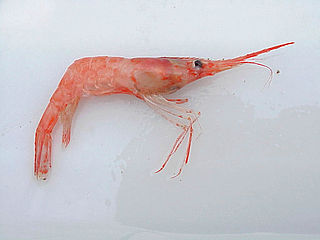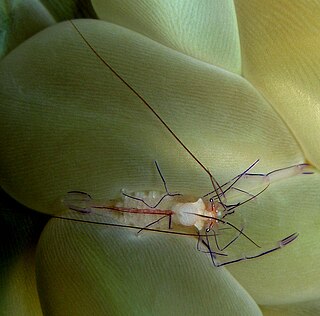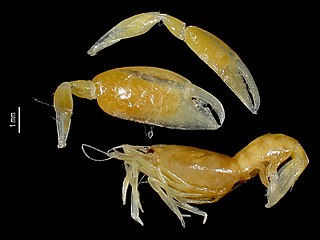
The family Pandalidae is a taxon of caridean shrimp. These species are commonly called pandalid shrimp. They are edible and have high economic value. They are characterised by the subdivided carpus of the second pereiopod and, mainly, by the lack of the chelae (claws) on the first pereiopod. This is a cold-water family, and their representation in tropical areas is made by deep-sea shrimp. The genus Physetocaris, sometimes placed in this family, is now considered to be in its own family, Physetocarididae.

Lipke Bijdeley Holthuis was a Dutch carcinologist, considered one of the "undisputed greats" of carcinology, and "the greatest carcinologist of our time".

Hippolyte is a genus of shrimp in the family Hippolytidae, containing the following species:

Palaemonidae is a family of shrimp in the order Decapoda. Many species are carnivores that eat small invertebrates, and can be found in any aquatic habitat except the deep sea. One significant genus is Macrobrachium, which contains commercially fished species. Others inhabit coral reefs, where they associate with certain invertebrates, such as sponges, cnidarians, mollusks, and echinoderms, as cleaner shrimps, parasites, or commensals. They generally feed on detritus, though some are carnivores and hunt tiny animals.

Palaemon is a genus of caridean shrimp in the family Palaemonidae.

The Rijksmuseum van Natuurlijke Historie was a museum on the Rapenburg in Leiden, the Netherlands. It was founded in 1820 by Royal Decree from a merger of several existing collections including Temmincks own collection. This happened on the initiative of Coenraad Jacob Temminck, who saw the museum primarily as a research institute for the University of Leiden. The total collection was already quite large at the time, and continued to grow from foreign expeditions and by obtaining private collections from inheritances. The location is currently used by the Rijksmuseum van Oudheden.
Atya is a genus of freshwater shrimp of the family Atyidae, ranging through the Antilles and along the Atlantic and Pacific slopes of Central and South America and in western Africa. It contains the following species:
Raymond Brendan Manning was an American carcinologist, specialising in alpha taxonomy and mantis shrimp.
Fenner Albert Chace Jr. was an American carcinologist.

Macrobrachium is a genus of freshwater prawns or shrimps characterised by the extreme enlargement of the second pair of pereiopods, at least in the male.
Juxtastenopus spinulatus is a species of stenopodidean shrimp. It lives in the Red Sea, and across the Indian Ocean as far east as the Philippines. It is red or pink, up to 28 mm (1.1 in) long, with enlarged third pereiopods. Originally described in the genus Engystenopus, it is now placed in the monotypic genus Juxtastenopus, in the family Stenopodidae.
Calliasmata is a genus of shrimp in the family Barbouriidae, containing the following species:

Palaemonella is a genus of shrimp in the family Palaemonidae, containing the following species:

Vir is a genus of shrimp comprising the following species:

Periclimenaeus is a genus of decapod crustaceans of the family Palaemonidae which is part of the infraorder Caridea. The genus was named by the English carcinologist Lancelot Alexander Borradaile in 1915. He set out the distinguishing features of the genus as:
Body rather stout, cephalothorax deep, a good deal compressed, abdomen greatly curved Thorax without dorsal swelling. Rostrum rather short, compressed, toothed above only. Outer antennular flagellum not deeply cleft. Antennal scale of good breadth. Mandible without palp. Second maxilliped without podopalp. Third maxilliped narrow, with vestigial arthrobranch.

Periclimenes, commonly known as glass shrimp or cleaner shrimp, is a commensal and often symbiotic genus of semi-transparent shrimp within the family Palaemonidae. Species of this large genus feature a wide variety of coloration and patterns, widespread distribution throughout much of the world's tropical oceans, and are often sought out for aquarium trade.
Neopontonides is a genus of shrimps belonging to the family Palaemonidae.

Dactylonia is a genus of shrimp in the family Palaemonidae, first described by Charles Fransen in 2002.
Dactylonia holthuisi is a small shrimp in the family Palaemonidae, first described by Charles Fransen in 2002. The species epithet honours Lipke Holthuis.











